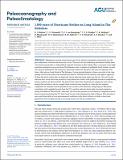| dc.contributor.author | Wallace, E. J. | |
| dc.contributor.author | Donnelly, J. P. | |
| dc.contributor.author | van Hengstum, P. J. | |
| dc.contributor.author | Winkler, T. S. | |
| dc.contributor.author | McKeon, K. | |
| dc.contributor.author | MacDonald, D. | |
| dc.contributor.author | d'Entremont, N. E. | |
| dc.contributor.author | Sullivan, R. M. | |
| dc.contributor.author | Woodruff, J. D. | |
| dc.contributor.author | Hawkes, A. D. | |
| dc.contributor.author | Maio, C. | |
| dc.date.accessioned | 2022-04-14T15:04:59Z | |
| dc.date.available | 2022-03-16T14:31:13Z | |
| dc.date.available | 2022-04-14T15:04:59Z | |
| dc.date.issued | 2021-03 | |
| dc.identifier.issn | 2572-4517 | |
| dc.identifier.issn | 2572-4525 | |
| dc.identifier.uri | https://hdl.handle.net/1721.1/141209.2 | |
| dc.description.abstract | Sedimentary records of past hurricane activity indicate centennial-scale periods over the
past millennium with elevated hurricane activity. The search for the underlying mechanism behind these
active hurricane periods is confounded by regional variations in their timing. Here, we present a new high
resolution paleohurricane record from The Bahamas with a synthesis of published North Atlantic records
over the past millennium. We reconstruct hurricane strikes over the past 1,050 years in sediment cores
from a blue hole on Long Island in The Bahamas. Coarse-grained deposits in these cores date to the close
passage of seven hurricanes over the historical interval. We find that the intensity and angle of approach
of these historical storms plays an important role in inducing storm surge near the site. Our new record
indicates four active hurricane periods on Long Island that conflict with published records on neighboring
islands (Andros and Abaco Island). We demonstrate these three islands do not sample the same storms
despite their proximity, and we compile these reconstructions together to create the first regional
compilation of annually resolved paleohurricane records in The Bahamas. Integrating our Bahamian
compilation with compiled records from the U.S. coastline indicates basin-wide increased storminess
during the Medieval Warm Period. Afterward, the hurricane patterns in our Bahamian compilation match
those reconstructed along the U.S. East Coast but not in the northeastern Gulf of Mexico. This disconnect
may result from shifts in local environmental conditions in the North Atlantic or shifts in hurricane
populations from straight-moving to recurving storms over the past millennium. | en_US |
| dc.publisher | American Geophysical Union (AGU) | en_US |
| dc.relation.isversionof | 10.1029/2020pa004156 | en_US |
| dc.rights | Creative Commons Attribution 4.0 International license | en_US |
| dc.rights.uri | https://creativecommons.org/licenses/by/4.0/ | en_US |
| dc.source | Wiley | en_US |
| dc.title | 1,050 years of Hurricane Strikes on Long Island in The Bahamas | en_US |
| dc.type | Article | en_US |
| dc.identifier.citation | Wallace, E. J., Donnelly, J. P., van
Hengstum, P. J., Winkler, T. S.,
McKeon, K., MacDonald, D., et al.
(2021). 1,050 years of hurricane strikes
on Long Island in The Bahamas.
Paleoceanography and Paleoclimatology,
36, e2020PA004156 | en_US |
| dc.contributor.department | Joint Program in Oceanography | en_US |
| dc.relation.journal | Paleoceanography and Paleoclimatology | en_US |
| dc.eprint.version | Final published version | en_US |
| dc.type.uri | http://purl.org/eprint/type/JournalArticle | en_US |
| eprint.status | http://purl.org/eprint/status/PeerReviewed | en_US |
| dspace.date.submission | 2022-03-16T14:08:36Z | |
| mit.journal.volume | 36 | en_US |
| mit.journal.issue | 3 | en_US |
| mit.license | PUBLISHER_CC | |
| mit.metadata.status | Publication Information Needed | en_US |

